Peng Fu
DIVE into MoE: Diversity-Enhanced Reconstruction of Large Language Models from Dense into Mixture-of-Experts
Jun 11, 2025Abstract:Large language models (LLMs) with the Mixture-of-Experts (MoE) architecture achieve high cost-efficiency by selectively activating a subset of the parameters. Despite the inference efficiency of MoE LLMs, the training of extensive experts from scratch incurs substantial overhead, whereas reconstructing a dense LLM into an MoE LLM significantly reduces the training budget. However, existing reconstruction methods often overlook the diversity among experts, leading to potential redundancy. In this paper, we come up with the observation that a specific LLM exhibits notable diversity after being pruned on different calibration datasets, based on which we present a Diversity-Enhanced reconstruction method named DIVE. The recipe of DIVE includes domain affinity mining, pruning-based expert reconstruction, and efficient retraining. Specifically, the reconstruction includes pruning and reassembly of the feed-forward network (FFN) module. After reconstruction, we efficiently retrain the model on routers, experts and normalization modules. We implement DIVE on Llama-style LLMs with open-source training corpora. Experiments show that DIVE achieves training efficiency with minimal accuracy trade-offs, outperforming existing pruning and MoE reconstruction methods with the same number of activated parameters.
Adapt Once, Thrive with Updates: Transferable Parameter-Efficient Fine-Tuning on Evolving Base Models
Jun 07, 2025Abstract:Parameter-efficient fine-tuning (PEFT) has become a common method for fine-tuning large language models, where a base model can serve multiple users through PEFT module switching. To enhance user experience, base models require periodic updates. However, once updated, PEFT modules fine-tuned on previous versions often suffer substantial performance degradation on newer versions. Re-tuning these numerous modules to restore performance would incur significant computational costs. Through a comprehensive analysis of the changes that occur during base model updates, we uncover an interesting phenomenon: continual training primarily affects task-specific knowledge stored in Feed-Forward Networks (FFN), while having less impact on the task-specific pattern in the Attention mechanism. Based on these findings, we introduce Trans-PEFT, a novel approach that enhances the PEFT module by focusing on the task-specific pattern while reducing its dependence on certain knowledge in the base model. Further theoretical analysis supports our approach. Extensive experiments across 7 base models and 12 datasets demonstrate that Trans-PEFT trained modules can maintain performance on updated base models without re-tuning, significantly reducing maintenance overhead in real-world applications.
Advantageous Parameter Expansion Training Makes Better Large Language Models
May 30, 2025
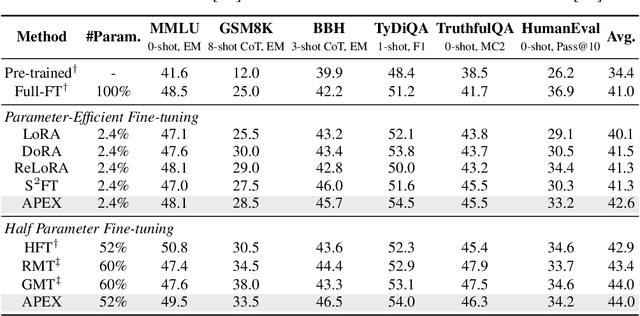
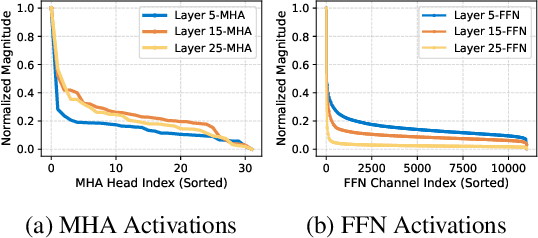
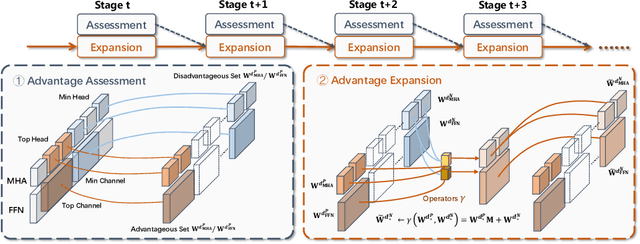
Abstract:Although scaling up the number of trainable parameters in both pre-training and fine-tuning can effectively improve the performance of large language models, it also leads to increased computational overhead. When delving into the parameter difference, we find that a subset of parameters, termed advantageous parameters, plays a crucial role in determining model performance. Further analysis reveals that stronger models tend to possess more such parameters. In this paper, we propose Advantageous Parameter EXpansion Training (APEX), a method that progressively expands advantageous parameters into the space of disadvantageous ones, thereby increasing their proportion and enhancing training effectiveness. Further theoretical analysis from the perspective of matrix effective rank explains the performance gains of APEX. Extensive experiments on both instruction tuning and continued pre-training demonstrate that, in instruction tuning, APEX outperforms full-parameter tuning while using only 52% of the trainable parameters. In continued pre-training, APEX achieves the same perplexity level as conventional training with just 33% of the training data, and yields significant improvements on downstream tasks.
BeamLoRA: Beam-Constraint Low-Rank Adaptation
Feb 19, 2025Abstract:Due to the demand for efficient fine-tuning of large language models, Low-Rank Adaptation (LoRA) has been widely adopted as one of the most effective parameter-efficient fine-tuning methods. Nevertheless, while LoRA improves efficiency, there remains room for improvement in accuracy. Herein, we adopt a novel perspective to assess the characteristics of LoRA ranks. The results reveal that different ranks within the LoRA modules not only exhibit varying levels of importance but also evolve dynamically throughout the fine-tuning process, which may limit the performance of LoRA. Based on these findings, we propose BeamLoRA, which conceptualizes each LoRA module as a beam where each rank naturally corresponds to a potential sub-solution, and the fine-tuning process becomes a search for the optimal sub-solution combination. BeamLoRA dynamically eliminates underperforming sub-solutions while expanding the parameter space for promising ones, enhancing performance with a fixed rank. Extensive experiments across three base models and 12 datasets spanning math reasoning, code generation, and commonsense reasoning demonstrate that BeamLoRA consistently enhances the performance of LoRA, surpassing the other baseline methods.
Multimodal Hypothetical Summary for Retrieval-based Multi-image Question Answering
Dec 19, 2024Abstract:Retrieval-based multi-image question answering (QA) task involves retrieving multiple question-related images and synthesizing these images to generate an answer. Conventional "retrieve-then-answer" pipelines often suffer from cascading errors because the training objective of QA fails to optimize the retrieval stage. To address this issue, we propose a novel method to effectively introduce and reference retrieved information into the QA. Given the image set to be retrieved, we employ a multimodal large language model (visual perspective) and a large language model (textual perspective) to obtain multimodal hypothetical summary in question-form and description-form. By combining visual and textual perspectives, MHyS captures image content more specifically and replaces real images in retrieval, which eliminates the modality gap by transforming into text-to-text retrieval and helps improve retrieval. To more advantageously introduce retrieval with QA, we employ contrastive learning to align queries (questions) with MHyS. Moreover, we propose a coarse-to-fine strategy for calculating both sentence-level and word-level similarity scores, to further enhance retrieval and filter out irrelevant details. Our approach achieves a 3.7% absolute improvement over state-of-the-art methods on RETVQA and a 14.5% improvement over CLIP. Comprehensive experiments and detailed ablation studies demonstrate the superiority of our method.
Reconstruction of Differentially Private Text Sanitization via Large Language Models
Oct 16, 2024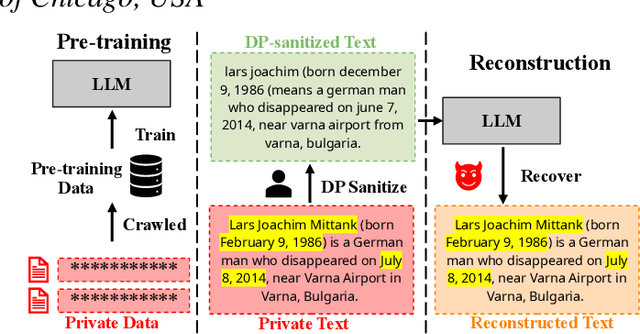

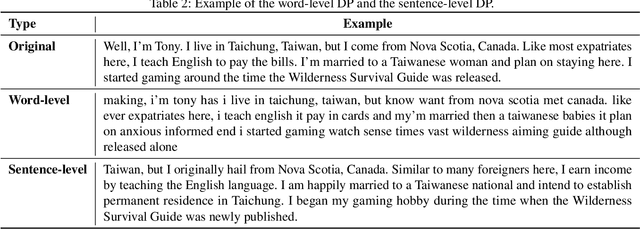
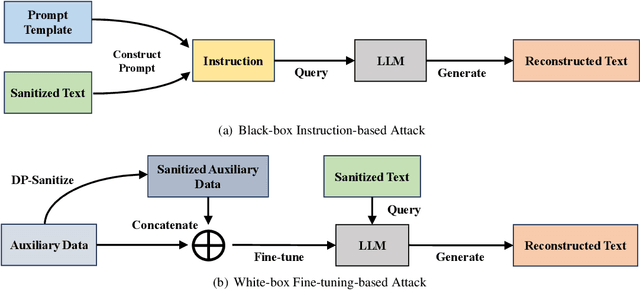
Abstract:Differential privacy (DP) is the de facto privacy standard against privacy leakage attacks, including many recently discovered ones against large language models (LLMs). However, we discovered that LLMs could reconstruct the altered/removed privacy from given DP-sanitized prompts. We propose two attacks (black-box and white-box) based on the accessibility to LLMs and show that LLMs could connect the pair of DP-sanitized text and the corresponding private training data of LLMs by giving sample text pairs as instructions (in the black-box attacks) or fine-tuning data (in the white-box attacks). To illustrate our findings, we conduct comprehensive experiments on modern LLMs (e.g., LLaMA-2, LLaMA-3, ChatGPT-3.5, ChatGPT-4, ChatGPT-4o, Claude-3, Claude-3.5, OPT, GPT-Neo, GPT-J, Gemma-2, and Pythia) using commonly used datasets (such as WikiMIA, Pile-CC, and Pile-Wiki) against both word-level and sentence-level DP. The experimental results show promising recovery rates, e.g., the black-box attacks against the word-level DP over WikiMIA dataset gave 72.18% on LLaMA-2 (70B), 82.39% on LLaMA-3 (70B), 75.35% on Gemma-2, 91.2% on ChatGPT-4o, and 94.01% on Claude-3.5 (Sonnet). More urgently, this study indicates that these well-known LLMs have emerged as a new security risk for existing DP text sanitization approaches in the current environment.
Advancing Academic Knowledge Retrieval via LLM-enhanced Representation Similarity Fusion
Oct 14, 2024
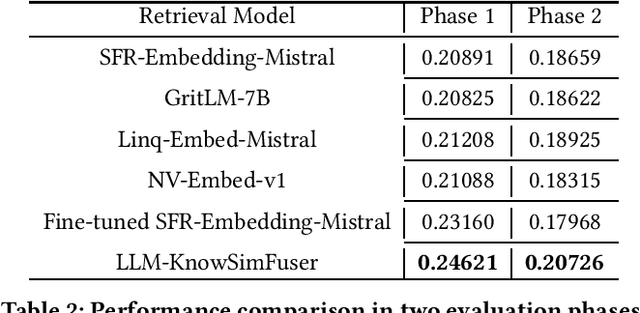

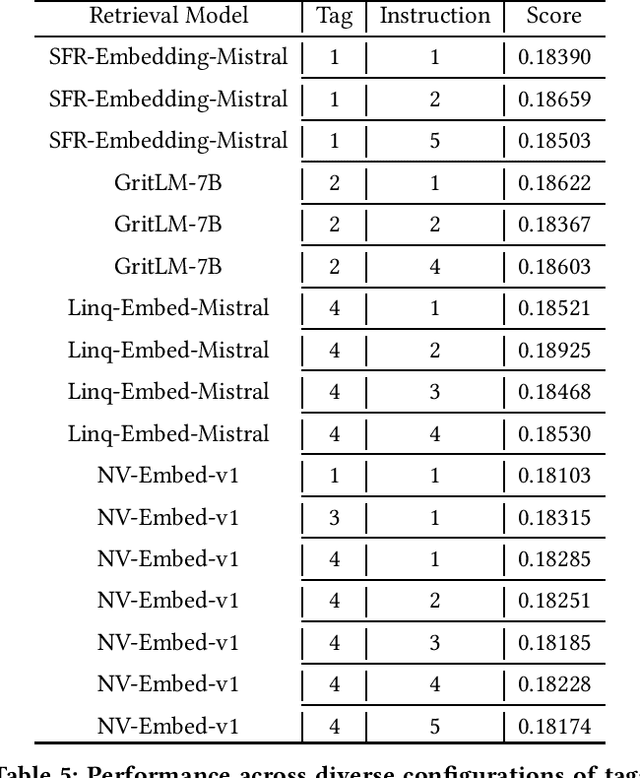
Abstract:In an era marked by robust technological growth and swift information renewal, furnishing researchers and the populace with top-tier, avant-garde academic insights spanning various domains has become an urgent necessity. The KDD Cup 2024 AQA Challenge is geared towards advancing retrieval models to identify pertinent academic terminologies from suitable papers for scientific inquiries. This paper introduces the LLM-KnowSimFuser proposed by Robo Space, which wins the 2nd place in the competition. With inspirations drawed from the superior performance of LLMs on multiple tasks, after careful analysis of the provided datasets, we firstly perform fine-tuning and inference using LLM-enhanced pre-trained retrieval models to introduce the tremendous language understanding and open-domain knowledge of LLMs into this task, followed by a weighted fusion based on the similarity matrix derived from the inference results. Finally, experiments conducted on the competition datasets show the superiority of our proposal, which achieved a score of 0.20726 on the final leaderboard.
Think out Loud: Emotion Deducing Explanation in Dialogues
Jun 07, 2024Abstract:Humans convey emotions through daily dialogues, making emotion understanding a crucial step of affective intelligence. To understand emotions in dialogues, machines are asked to recognize the emotion for an utterance (Emotion Recognition in Dialogues, ERD); based on the emotion, then find causal utterances for the emotion (Emotion Cause Extraction in Dialogues, ECED). The setting of the two tasks requires first ERD and then ECED, ignoring the mutual complement between emotion and cause. To fix this, some new tasks are proposed to extract them simultaneously. Although the current research on these tasks has excellent achievements, simply identifying emotion-related factors by classification modeling lacks realizing the specific thinking process of causes stimulating the emotion in an explainable way. This thinking process especially reflected in the reasoning ability of Large Language Models (LLMs) is under-explored. To this end, we propose a new task "Emotion Deducing Explanation in Dialogues" (EDEN). EDEN recognizes emotion and causes in an explicitly thinking way. That is, models need to generate an explanation text, which first summarizes the causes; analyzes the inner activities of the speakers triggered by the causes using common sense; then guesses the emotion accordingly. To support the study of EDEN, based on the existing resources in ECED, we construct two EDEN datasets by human effort. We further evaluate different models on EDEN and find that LLMs are more competent than conventional PLMs. Besides, EDEN can help LLMs achieve better recognition of emotions and causes, which explores a new research direction of explainable emotion understanding in dialogues.
Light-PEFT: Lightening Parameter-Efficient Fine-Tuning via Early Pruning
Jun 06, 2024Abstract:Parameter-efficient fine-tuning (PEFT) has emerged as the predominant technique for fine-tuning in the era of large language models. However, existing PEFT methods still have inadequate training efficiency. Firstly, the utilization of large-scale foundation models during the training process is excessively redundant for certain fine-tuning tasks. Secondly, as the model size increases, the growth in trainable parameters of empirically added PEFT modules becomes non-negligible and redundant, leading to inefficiency. To achieve task-specific efficient fine-tuning, we propose the Light-PEFT framework, which includes two methods: Masked Early Pruning of the Foundation Model and Multi-Granularity Early Pruning of PEFT. The Light-PEFT framework allows for the simultaneous estimation of redundant parameters in both the foundation model and PEFT modules during the early stage of training. These parameters can then be pruned for more efficient fine-tuning. We validate our approach on GLUE, SuperGLUE, QA tasks, and various models. With Light-PEFT, parameters of the foundation model can be pruned by up to over 40%, while still controlling trainable parameters to be only 25% of the original PEFT method. Compared to utilizing the PEFT method directly, Light-PEFT achieves training and inference speedup, reduces memory usage, and maintains comparable performance and the plug-and-play feature of PEFT.
Are Large Language Models Table-based Fact-Checkers?
Feb 04, 2024Abstract:Table-based Fact Verification (TFV) aims to extract the entailment relation between statements and structured tables. Existing TFV methods based on small-scaled models suffer from insufficient labeled data and weak zero-shot ability. Recently, the appearance of Large Language Models (LLMs) has gained lots of attraction in research fields. They have shown powerful zero-shot and in-context learning abilities on several NLP tasks, but their potential on TFV is still unknown. In this work, we implement a preliminary study about whether LLMs are table-based fact-checkers. In detail, we design diverse prompts to explore how the in-context learning can help LLMs in TFV, i.e., zero-shot and few-shot TFV capability. Besides, we carefully design and construct TFV instructions to study the performance gain brought by the instruction tuning of LLMs. Experimental results demonstrate that LLMs can achieve acceptable results on zero-shot and few-shot TFV with prompt engineering, while instruction-tuning can stimulate the TFV capability significantly. We also make some valuable findings about the format of zero-shot prompts and the number of in-context examples. Finally, we analyze some possible directions to promote the accuracy of TFV via LLMs, which is beneficial to further research of table reasoning.
 Add to Chrome
Add to Chrome Add to Firefox
Add to Firefox Add to Edge
Add to Edge